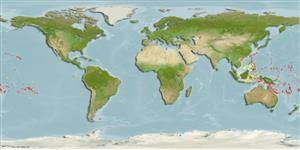Klassifizierung / Names
Namen | Synonyme | Catalog of Fishes(Gattung, Arten) | ITIS | CoL | WoRMS | Cloffa
>
Gobiiformes (Gobies) >
Gobiidae (Gobies) > Gobiinae
Etymology: Eviota: No etymology given, suggested by Christopher Scharpt: from Latin 'eu' for 'true' and 'iota' for anything very small, in combination 'truly very small' referring to it as being the smallest vertebrate at the time it has benn described by Jenkins (thus, making the suggestion by Scharpt plausible.; randalli: Named for John E. Randall; patronym in genitive case..
More on author: Greenfield.
Environment: milieu / climate zone / depth range / distribution range
Ökologie
seewasser riff-verbunden; tiefenbereich 3 - 17 m (Ref. 83326). Tropical
Pacific: Fiji, Tahiti and Samoa Islands; Palau specimens .incertae sedis.
Size / Gewicht / Alter
Maturity: Lm ? range ? - ? cm
Max length : 1.8 cm SL Männchen/unbestimmt; (Ref. 83326); 1.7 cm SL (female)
Kurzbeschreibung
Morphologie | Morphometrie
Rückenflossenstacheln (insgesamt): 7; Rückenflossenweichstrahlen (insgesamt): 8; Afterflossenstacheln 1; Afterflossenweichstrahlen: 8. This species is distinct in having the following characters: D VI+I,8, A I,8; pectoral-fin rays branched, only starting with ray 10 (usually 11 or 12); cephalic sensory-pore system pattern I (complete); absence of fifth segmented pelvic-fin ray; 3-4 branches on fourth pelvic-fin ray, 3-7 segments between branches (usually 3-4); non-fimbriated genital papilla; slightly filamentous dorsal fin; 3 internal dark bars between anal-fin origin and caudal fin; lower half of pectoral-fin base with a distinct dark spot and anterior to the base is a white area (Ref. 83326). Dorsal to anal fin-ray formula 8/8.
Life cycle and mating behavior
Geschlechtsreife | Fortpflanzung | Ablaichen | Eier | Fecundity | Larven
Greenfield, D.W., 2009. Eviota randalli, a new gobiid fish from Oceania. Proc. Calif. Acad. Sci. 60(20):683-687. (Ref. 83326)
IUCN Rote Liste Status (Ref. 130435)
Bedrohung für Menschen
Harmless
Nutzung durch Menschen
Mehr Information
NamenSynonymeMetabolismusRäuberÖkotoxikologieFortpflanzungGeschlechtsreifeAblaichenSpawning aggregationFecundityEierEientwicklung
Alter/GrößeWachstumLänge-GewichtLänge-LängeLängenhäufigkeitenMorphometrieMorphologieLarvenLarven Pop.Dyn.RekrutierungDichteBRUVS
ReferenzenAquakulturAquakultur ProfilZuchtlinienGenetikElectrophoresesVererbbarkeitKrankheitenVerarbeitungNutrientsMass conversion
PartnerBilderStamps, Coins Misc.LauteCiguateraGeschwindigkeitSchwimmstilKiemenoberflächeOtolithsGehirngrößeSehfähigkeit
Tools
Zusatzinformationen
Download XML
Internet Quellen
Estimates based on models
Preferred temperature (Ref.
123201): 25 - 29.4, mean 28 °C (based on 1120 cells).
Phylogenetic diversity index (Ref.
82804): PD
50 = 0.5000 [Uniqueness, from 0.5 = low to 2.0 = high].
Bayesian length-weight: a=0.01023 (0.00477 - 0.02194), b=3.02 (2.84 - 3.20), in cm total length, based on LWR estimates for this (Sub)family-body shape (Ref.
93245).
Trophic level (Ref.
69278): 3.0 ±0.3 se; based on size and trophs of closest relatives
Fishing Vulnerability (Ref.
59153): Low vulnerability (10 of 100).
